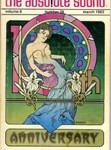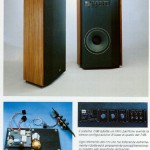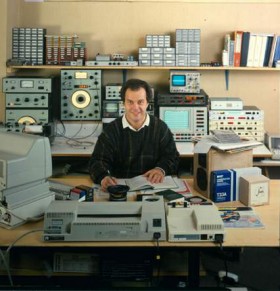Doug Sax è il fondatore della Sheffield Lab (Casa discografica responsabile di molte fra le migliori registrazioni Direct-To-Disc esistenti, oggetto di culto da parte degli audiofili di tutto il mondo)
Dopo una visita al Winter CES (Consumer Electronics Show) tenutasi a Las Vegas a gennaio 1983 così si esprimeva dalle pagine di the abso!ute sound.
Doug Sax on the Loose at CES
Dear Harry:
have just returned from CES In Vegas and I thought you and your readers might like to have an insider’s view of the show.
In light of the economic conditions would strongly urge the CES to think about the way the Audio Engineering Society does it. The AES has one show a year, annually alternating between the West and East coasts. That countless manufacturers have to go through this type of masochistic endeavor twice a year is inhumane. The expense for the retailers to attend is out of sight. To what purpose? Certainly nothing earth-shattering in any consumer lines will happen in the next six months.
Sheffield Lab, as a manufacturer, displays at all CES’s, and it is the only format public exposure that we use. This is only the third show that I have attended in live years. I went to gain knowledge first-hand, take the pulse of the audiophile industry. As you know, both of my business enterprises, Sheffield Lab and The Mastering Lab, are concerned solely with the phonograph record, and the coming of the Compact Disc is an event I could not fail to evaluate. It remains an enigma. It offers more than an hour of uninterrupted music in a very compact size. And yet, the sound is disappointing: technical perfection in mediocrity. I cannot believe that a true music lover will be able to accept it. I found it less of a threat to my survival than I had expected -
Now off to the Riviera Hotel to see the real nuts. The harsh economic conditions have already taken their toll in the record industry. The decline started five years ago. and has resulted in the closing of pressing facilities, the firing of countless employees by all record companies, and the depressing aroma of panic permeates everything. Two independent disc mastering facilities bit the bullet in 1982, and more will follow in 1983. The men are being separated from the boys. (Where are my hormones?)
The same is true for the manufacturers of High End audio equipment. Chapter Eleven is becoming a best-seller. Talk of companies in trouble abounded along with comments of regret and alarm. The hard reality is that many more companies, large and small, are in serious trouble. As with the record industry, their production capabilities will have to be sleeved down to the size of the market. Our economic depression is not all:The consumer has a positively endless choice of consumables to challenge the audio dollar in the form of video recorders, video discs, video games, and those amazing home computers. Any retailer must choose carefully as to where he is going to spend his money and must decide accurately which way the wind is blowing. It certainly wasn’t blowing towards the Riviera, and, frankly, the interest shown by retailers to the High End display at the Riviera was lukewarm at best.
As one involved in audio, I could not be but impressed by what was really going on at the Riviera. Each small suite represented, for the most part, a true music lover, someone whose involvement in the reproduction of music has moved them to commit all their resources to some area in the playback chain where they feel they can make a meaningful contribution.
I had the pleasure of meeting John Iverson who was showing his new amplifier. A quick glance inside his amp revealed a staggering parts count. Assuming that all are there for a reason, the time and energy involved becomes obvious. John, of course, is only one man in one room and the rooms go on and on. John was smoking ordinary cigarettes and guzzling Jack Daniel. After he filled my glass to the rim, I asked him the obvious: What the hell are you doing back in the sweat box? Said he, laughing, “Once you’re bitten by the audio bug you can’t shake it. It’s a life-long addiction.” The Riviera was full of addicts, and it is with sorrow that I foresee that some are not going to survive their addiction. The rest of my stay was the enjoyable part. I got to be an audiophile for a day. With my good friend Bob Neil from Visalia, I went through many of the rooms to hear what there was to hear. A note to exhibitors:
Always have your system playing. A room with no music in it is just another dreary hotel room. Do your talking somewhere else.
Trends? I think so. Dynamic speakers are getting better. It was a bad day for electrostatics. They ranged from fair to awful. Naturally, I would miss the set that apparently thrilled everybody: the Sound Lab’s A/1 designed by Dr. Roger West.
My method: Stick my head in the door -if the sound was inviting, go in and give the system a fair shake. My interest at this show was in loudspeakers since many turntables, cartridges, and amplitiers are doing the job. Many of the speakers I heard could not be called systems. They might handle some area of the signal properly, but they were failures as systems capable of doing most ot what should be expected. I should mention that I feel this way about most of the speakers that have ever been offered for sale.
I didn’t make all the rooms, but I did hear some systems that were, indeed, systems. Vandersteen, the RS-1 of Intinity, Meridian, Linn, the nefarious Klipsch, and, surprise, the LJ260 of JBL. The surprise is that this is the first JBL I have ever considered a sysem. Maybe John Eargle has finally got something through. All are compromises, but, then, I don’t expect much from a loudspeaker.
After five hours of this madness we were pooping out, but we hear a vocal -Amanda’s, it so happened-coming from some unknown speaker. It is instantly obvious that this is the best I’ve ever heard her sound, save for standing next to her. We went in and sat down and really listened. Everything sounded glorious and musical. I introduoed myself to Arthur Regal from Cedarhurst, N.Y. He is president of ESB USA and will be importing the ESB line from Italy. He asked me if I would like to hear some other Sheffield records. No. anything but that. He then put on a Proprius recording, Cantate Domino. Again, the best reproduction of voice have ever heard. The recording was superb. (Every audiophile should have some Proprius recordings, and the same is true of the Opus 3 line from Sweden.)
Impressed out of my shorts, we bade adieu to ESBand ventured further down the hall where I had a rather joyous meeting with my old friend Leode Gar Kulka of Sonic Arts. I met Leo in 1961 when Lincoln and I were attempting to make a direct-to-disc recording of a solo piano -and mono at that. He had the only Neumann cutting system In Los Angeles. He played some of his new recordings for us, and I ran around the show until I collared a pressing of our disc of Arnold Steinhardt and Lincoln doing the Strauss sonata, it sounded unfamiliar on the set-up in Leo’s shared room, and next door we tried it on some weird-looking speaker that sounded even weirder. Since I feel this is the best recording I have ever made, was disappointed that I couldn’t show Leo its virtues. Bob suggested that we go back to ESB to listen to the Strauss, great idea, Bob, We went and listened to the whole sonata. I can’t remember the last time that listened through a complete work. The result was stunning, way beyond acourate; a seamless, effortless recreation of the instruments, the room, the musician’s interplay and emotion- I have never heard a speaker re-create the spatiality of these Italian wonders. The ESB 7/06, A restorative experience. Maybe it is all worthwhile. Special accolades to everything in the playback chain which performed without a trace of mechanical or electrical presence. SOTA sapphire turntable, Lustre 801 arm, high output SDX 2000 Supex, Threshold FET 1 preamp, Threshold S500 power amp.
It was then 9 p.m. and everyone famished. We went to the buffet at Circus, Circus; Bob Neil, Arthur Regal, Renato Giussani (the designer of the ESB 7/06).
I pumped Renato concerning the design parameters of his wondrous loudspeaker. Apparently he has done much research into what a speaker must do to allow the ear to receive space and depth information. What we all heard was no accident. As a professional, I can guarantee that the speaker will fail in many areas; as an audiophile tor a day, I know it is the finest loudspeaker I’ve ever heard.
At a table nearby some people are conversing passionately over amplifier probems and crossover designs. Bob Iverson stops at our table and we exchange pleasantries; addicts all.
—Doug Sax
Postscript:
I have just listened to Leo’s Sonic Arts recording of Stephen Kates doing the Rachmaninov Cello Sonata. It sounds lovely, and it’s digital yet. Harry, what’s happening to me?
Un estratto in italiano
“…Il resto della giornata è stato la parte divertente. Sono stato un audiofilo per un giorno. Con il mio buon amico della Visalia, ho girato per la maggior parte delle sale per ascoltare quel che c’era da ascoltare…Molti degli altoparlanti che ho sentito non possono essere chiamati -sistemi-. Alcuni possono trattare alcune parti del segnale abbastanza bene, ma c’erano sempre carenze nel comportarsi come -sistemi- capaci di fare la maggior parte di quello che uno dovrebbe potersi aspettare. In verità io la penso così della maggior parte degli altoparlanti che sono sempre stati offerti sul mercato. Non ho girato tutte le stanze, ma ho ascoltato alcuni sistemi che erano, comunque, sistemi. Vandersteen, le RS-1 della Infinity, Meridian…Tutti sono compromessi, ma, dopotutto, io non mi aspetto molto da un altoparlante.
Dopo cinque ore di questa pazzia noi stavamo per scoppiare, quando sentimmo una voce -quella di Amanda- provenire da un altoparlante sconosciuto. E’ immediatamente ovvio che questa è la volta che sento al meglio il suo suono, tranne che standole in piedi vicino. Noi entrammo, ci sedemmo e in verità ascoltammo. Tutto suonava glorioso e musicale. Io mi presentai ad Arthur Regal di Cederhurst, N.Y. Egli è il presidente della ESB-USA e importerà la linea ESB dall’Italia. Egli mi chiese se volessi ascoltare qualche altro disco Sheffield. No, nient’altro. Allora lui mise una registrazione Propius, Cantate Domino. Di nuovo, la migliore riproduzione della voce che io abbia mai sentito. La registrazione era superba. Impressionati oltre ogni limite, noi dicemmo addio alla ESB e ci avventurammo in fondo all’ingresso, dove io ebbi un incontro più che gioioso con il mio vecchio amico Leode Gar Gulka della Sonic Arts. Io conobbi Gulka nel 1961 quando Lincoln ed io stavamo provando a fare una registrazione diretta su disco di un pianoforte, e mono anche. Allora lui aveva l’unica macchina per incisione Neumann in Los Angeles. Suonò alcune delle sue nuove registrazioni per noi, quindi io girai per la mostra finché non trovai una copia del nostro disco di Arnold Steinhardt e Lincoln che suonano la sonata di Strauss. Suonava poco familiare sull’impianto nella stanza di Leo. La porta accanto provammo con un sistema di altoparlanti piuttosto strano che suonava in modo ancora più strano. Dato che io credo che questa sia la migliore registrazione che io abbia mai fatto, era scoraggiante non riuscire a mostrare a Leo le sue qualità. Bob suggerì di tornare alla ESB per ascoltare Strauss. Grande idea Bob. Noi ci andammo ed ascoltammo l’intera sonata. Io non mi ricordo quale è stata l’ultima volta che ho riascoltato per intero un mio lavoro. Il risultato era emozionante, molto più che accurato; una perfetta ricostruzione priva di fatica degli strumenti, della stanza, dell’interpretazione dei musicisti e della loro emozione. Io non ho mai sentito un altoparlante ricreare la spazialità di queste meraviglie italiane. Le ESB 7/06. Una esperienza ristoratrice.
…Erano le 9 p.m. ed avevamo tutti familiarizzato. Andammo al buffet al Circus. Bob Neil, Arthur Regal, Renato Giussani (il progettista delle 7/06). Io sollecitai Renato a proposito dei parametri di progetto dei suoi meravigliosi altoparlanti. Sembrerebbe che abbia condotto una notevole ricerca su quello che un altoparlante deve fare per permettere all’orecchio di percepire le informazioni spaziali e di profondità. Quello che noi tutti avevamo sentito non era stato casuale…”
P.S.: Mio figlio Fabrizio mi ha fatto notare che il nome di Doug Sax compare all’interno della copertina del CD “Wish you where here” dei Pink Floyd (1975) come responsabile del remastering digitale effettuato ai The Mastering Lab LA nel 1992…
E, a distanza di parecchi anni… Mutatis mutandis…
Ecco un’altra testimonianza non da poco: l’opinione del discografico Marco Lincetto dopo l’ascolto delle GR Delta 4 R9 al Roma Hi-End 2009.
“…approfitto di questo lunghissimo 3D – anziché aprirne un altro analogo – per dire la mia su questi diffusori (n.d.r. GR Delta 4 R9), finalmente ascoltati, brevemente, ma con grande attenzione e concentrazione, al Roma Hi-End, utilizzando principlamente due miei master che conosco meglio di me stesso.
Ci tengo a scrivere queste poche righe, perché reputo Giussani una delle poche persone che ha lasciato il segno in questo settore, negli ultimi 40 anni almeno.
Quando da ragazzo, poco più che ventenne, iniziai a fare le cose sul serio, in questo mondo, il mio riferimento si chiamava ESB 7/06, ovvero un diffusore che era talmente innovatore allora, che pure oggi mantiene alcune caratteristiche di riferimento assoluto.
Ebbene, ascoltando l’ultima creatura in ordine di tempo del maestro Giussani non ho potuto non ritrovare una filosofia che procede lungo la strada maestra, senza mai perdere di vista i principi che ispirarono i primi progetti.
La coerenza: la coerenza di pensiero e di realizzazione, sintomo di profonda conoscenza, non disgiunta comunque da brillante intuito.
Nei primi 30 secondi di ascolto di questo diffusore ho immediatamente capito che tutto stava al suo posto: non ho avuto problemi a ritrovare tutti i riferimenti di due registrazioni che, appunto, conosco “più che benissimo”.
Ed il tutto in una saletta che, probabilmente apposta, riproduceva un ambiente domestico molto normale, usuale, ovvero l’ambiente dove verranno ascoltate questi diffusori.
Un sentito “Complimenti!” a Renato Giussani.
Marco Lincetto…”





